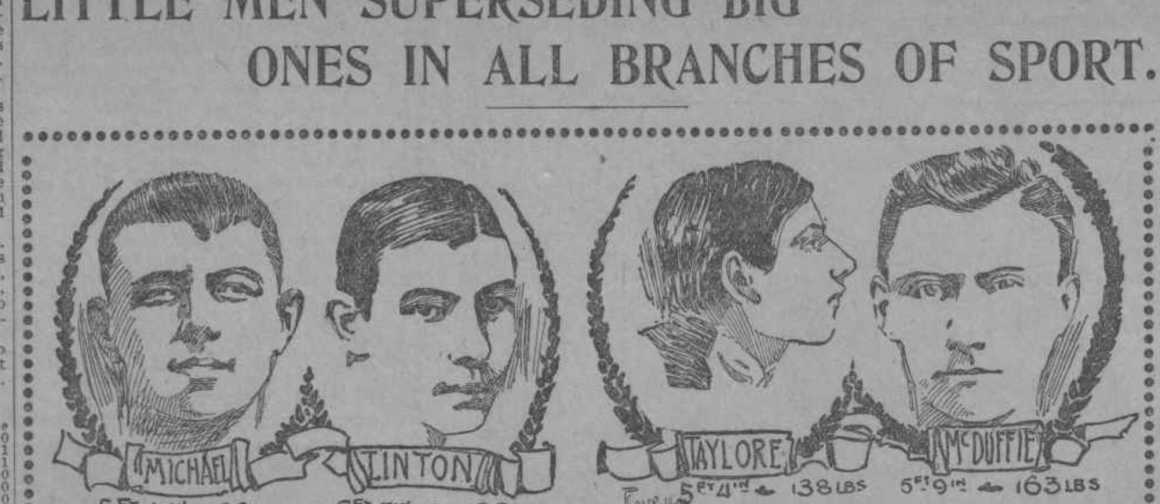
Here’s a weight-to-power editorial from 1898. That’s when it was the pygmies v. giants in cycling. And, when McDuffie 65 pounds heavier than Micheal and 8 and a 1/2 inches taller was described as “Looming up by the side of the little chap as an ocean liner by a tug.”

The New York Journal story continues….
“Here Read How Small Cyclers Are Getting the Best of Things. THREE of the four leading middle-distance cycle racers of the world are small men. The average weight of Edouard Taylore, Jimmy Michael and Tom Litton is 122 2-3 pounds. Their average height is 5 feet 3 3/4 inches. The fourth of the quartette, Eddie McDuffee, is 163 pounds in weight and 5 feet 9 inches in height.
The rivalry between this ‘bunch of four’ is the old story of the pygmies against the giants. It is a battle which has been fought in the last two decades in nearly every sport in the history of athletics. Little by little the big man has been forced to take a back seat. In baseball the most successful nines of the last six seasons have been those in which the small, agile and active players predominated.
In middle-distance cycle races the little men have recorded ten victories to each one for a big chap. In sprint cycle races on the contrary, the heavyweights have more than held their own from the days of Zimmerman down.
McDuffie’s advent from the sprinters to the middle-distance cycle world opens and interesting field of study for those who give their attention to the technique of racing and the study of physical development. Can he defeat the pigmies?
McDuffie, who was reasonably successful at sprints, is the only rider of the year whose work has been sufficlently good to put him in the same class with Linton, Taylore and Michael. Furthermore, with an exception or two, he is the only sprinter to give his attention to middle distance riding who has made any kind of success at it. Starbuck could ride sprint races, and tried his hand at middle distance racing, but it is generally conceded that he is outclassed in the latter branch by the men of the hour. Major Taylor, too, seems better than the average at both kinds of racing. McDuffle is sixty-five pounds heavier than Michael and eight and a half inches taller. He looms up by the side of the little chap as an ocean liner by a tug. He is thirty one pounds heavier than Linton and two inches taller. When McDulfie stands by the side of Taylore, the French boy, the same marked difference is evident. Taylore would seem to be outclassed were height and weight to the accepted factor in paced races.
Theorists of cycle racing have claimed that smaller men are more successful at middle-distance racing because their bodies offer less resistance to the atmosphere thus making it easier for them to follow pace.
Is this to be disproved by McDuffie, with his great excess of bodily weight, as compared with the three smaller men? Should he fail to vanquish both the Welshmen and the Frenchman the pigmies will have won their battle, and the interested public will naturally form the opinion that there something in the theory that smaller men are better adapted for pace following.
While touching upon the relation of size to cycle racing it is of interest to note that the champion sprinters of the past and present are mostly big men. Zimmerman, for example, king of them all, with his 165 pounds; Sanger, a winner in his day, who is even heavier; Bald, Gardiner, Cooper, all solid, strong, big muscled chaps, who make the wheels of bicycle sing as they push it around track. Linton has defeated Taylore once in this country; twice he was defeated by him in Paris. Linton has vet to meet McDuffle, Taylore races against the latter at Boston or next Saturday.
If he should win, if Linton should win and if Michael should win in a subsequent match from the American boy, it would be an overwhelming victory for the midgets!
If in time Michael should triumph effectively over all of them, not only would he establish his claim to being the best follower of pace in the world, but satisfy great many cranks that the small men handle themselves better behind the multicyles than the big fellows.”
It’s as if the author of the article was discussing Greipel and Cavendish or modern tour contenders in the mountains.
Theorists of cycle racing have claimed that smaller men are more successful at middle-distance racing because their bodies offer less resistance to the atmosphere thus making it easier for them to follow pace.
118 years later we pretty much discuss the same thing but current topics concern weight cutting, marginal gains, being aero, and whatever else cyclists can do to go fast.
My other fav line from the archive is this observance about the sheer power of a bigger man, “Those who make the wheels of bicycle sing as they push it around the track.”
For the record, the pygmies and giants took on different roles in cycling and the sport eventually favored road races over track events. We don’t call them that either. Instead, the terms are sprinters, climbers, all-arounders, and GC contenders.
…We're riding townies, adventure, and mountain bikes. Find recommendations on our store page. As Amazon Associates we earn from qualifying purchases.